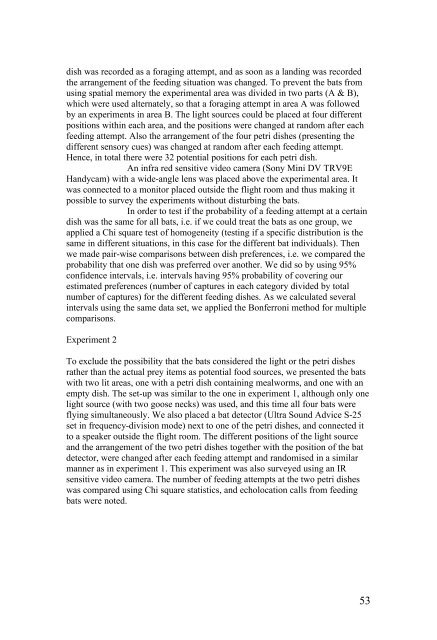Vision in echolocating bats - Fladdermus.net
Vision in echolocating bats - Fladdermus.net
Vision in echolocating bats - Fladdermus.net
Create successful ePaper yourself
Turn your PDF publications into a flip-book with our unique Google optimized e-Paper software.
dish was recorded as a forag<strong>in</strong>g attempt, and as soon as a land<strong>in</strong>g was recorded<br />
the arrangement of the feed<strong>in</strong>g situation was changed. To prevent the <strong>bats</strong> from<br />
us<strong>in</strong>g spatial memory the experimental area was divided <strong>in</strong> two parts (A & B),<br />
which were used alternately, so that a forag<strong>in</strong>g attempt <strong>in</strong> area A was followed<br />
by an experiments <strong>in</strong> area B. The light sources could be placed at four different<br />
positions with<strong>in</strong> each area, and the positions were changed at random after each<br />
feed<strong>in</strong>g attempt. Also the arrangement of the four petri dishes (present<strong>in</strong>g the<br />
different sensory cues) was changed at random after each feed<strong>in</strong>g attempt.<br />
Hence, <strong>in</strong> total there were 32 potential positions for each petri dish.<br />
An <strong>in</strong>fra red sensitive video camera (Sony M<strong>in</strong>i DV TRV9E<br />
Handycam) with a wide-angle lens was placed above the experimental area. It<br />
was connected to a monitor placed outside the flight room and thus mak<strong>in</strong>g it<br />
possible to survey the experiments without disturb<strong>in</strong>g the <strong>bats</strong>.<br />
In order to test if the probability of a feed<strong>in</strong>g attempt at a certa<strong>in</strong><br />
dish was the same for all <strong>bats</strong>, i.e. if we could treat the <strong>bats</strong> as one group, we<br />
applied a Chi square test of homogeneity (test<strong>in</strong>g if a specific distribution is the<br />
same <strong>in</strong> different situations, <strong>in</strong> this case for the different bat <strong>in</strong>dividuals). Then<br />
we made pair-wise comparisons between dish preferences, i.e. we compared the<br />
probability that one dish was preferred over another. We did so by us<strong>in</strong>g 95%<br />
confidence <strong>in</strong>tervals, i.e. <strong>in</strong>tervals hav<strong>in</strong>g 95% probability of cover<strong>in</strong>g our<br />
estimated preferences (number of captures <strong>in</strong> each category divided by total<br />
number of captures) for the different feed<strong>in</strong>g dishes. As we calculated several<br />
<strong>in</strong>tervals us<strong>in</strong>g the same data set, we applied the Bonferroni method for multiple<br />
comparisons.<br />
Experiment 2<br />
To exclude the possibility that the <strong>bats</strong> considered the light or the petri dishes<br />
rather than the actual prey items as potential food sources, we presented the <strong>bats</strong><br />
with two lit areas, one with a petri dish conta<strong>in</strong><strong>in</strong>g mealworms, and one with an<br />
empty dish. The set-up was similar to the one <strong>in</strong> experiment 1, although only one<br />
light source (with two goose necks) was used, and this time all four <strong>bats</strong> were<br />
fly<strong>in</strong>g simultaneously. We also placed a bat detector (Ultra Sound Advice S-25<br />
set <strong>in</strong> frequency-division mode) next to one of the petri dishes, and connected it<br />
to a speaker outside the flight room. The different positions of the light source<br />
and the arrangement of the two petri dishes together with the position of the bat<br />
detector, were changed after each feed<strong>in</strong>g attempt and randomised <strong>in</strong> a similar<br />
manner as <strong>in</strong> experiment 1. This experiment was also surveyed us<strong>in</strong>g an IR<br />
sensitive video camera. The number of feed<strong>in</strong>g attempts at the two petri dishes<br />
was compared us<strong>in</strong>g Chi square statistics, and echolocation calls from feed<strong>in</strong>g<br />
<strong>bats</strong> were noted.<br />
53


